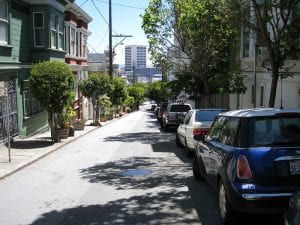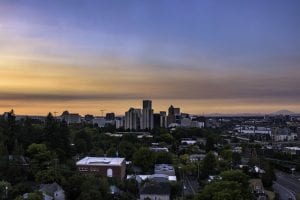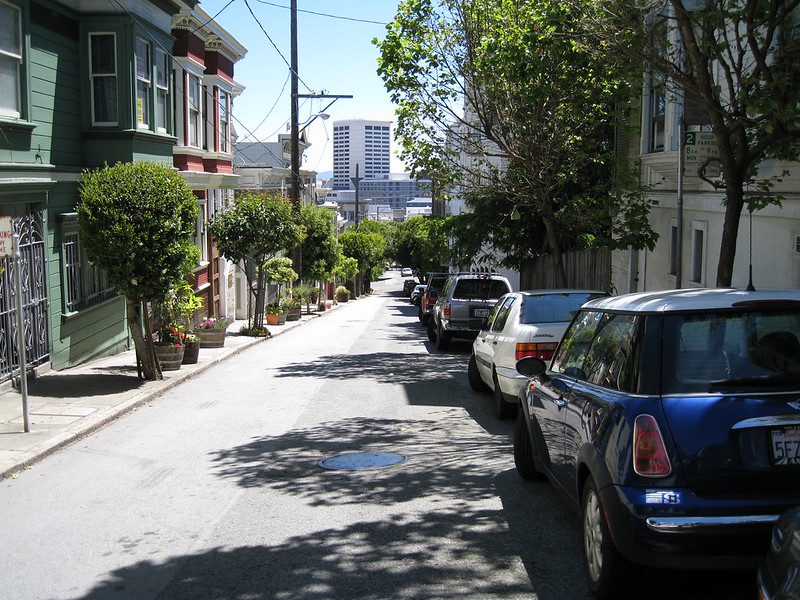
Lily Street in the Hayes Valley neighborhood of San Francisco. Photo by flickr user NACTO, CC BY-NC 2.0
Mario Watts grew up in San Francisco’s Hayes Valley when it was still one of the city’s prominent African-American neighborhoods.
Located in the Western Addition of the city, near the Fillmore District, Watts’s old neighborhood has changed dramatically over the course of his 42 years.
Today housing there is far beyond Watts’s income—at least without subsidy. Across the city, the median rent is over $1,700, while average home sale prices are well beyond $1.5 million. Still, there was never any question that he wanted to live in the Hayes Valley neighborhood with his son, if he could.
“I just love San Francisco, it’s my home,” says Watts, who lived in a car with his pre-teen son for years before he got his new apartment. “I lived in Texas, I lived in Oklahoma. But there’s something about [San Francisco] that is hard for me to leave. I’m always drawn back. It’s one of the best cities in the world to live in. People mind their own business, regardless of race or gender, and it’s open to anyone.”
Hayes Valley is Watts’s home again, and not only because of subsidized housing that’s been built in the neighborhood.
Watts had an advantage when the building he lives in opened because of a neighborhood preference policy that San Francisco—and a handful of other cities—have adopted to address displacement and gentrification.
When Watt’s name came up in the city’s housing lottery, he was alerted to the fact that as a former resident of Hayes Valley, he could receive “preference” for one of the homes in the new apartment complex, which included affordable units.
“I don’t think I could have found a place here without the neighborhood preference policy,” he says. Watts knows that the competition for affordable units in San Francisco is extremely intense. “I don’t think I could have done it without the city’s help.”
San Francisco created its neighborhood preference policy in 2015, becoming the second city in the country to establish such a law.
The basic idea is that new housing meant to serve lower-income and working-class populations should have some percentage of the project earmarked for residents of the neighborhood where the project will be built. This allows new apartment complexes to address not only affordability, but the harder-to-measure losses that come with demographic change in a neighborhood.
“Our policy came out of the displacement we saw happening in San Francisco, and it came from cries from our neighborhoods,” said Maria Benjamin, deputy director of the Mayor’s Office of Housing and Community Development. “This is a beautiful city. People want to stay here. [But] we are doing so much building here, tens of thousands of units, and people are being displaced from where they live.”
Since July 2016, 31 housing projects have been completed under the community preference policy, creating 629 units that have been marketed through the program. By June 30, 2023, a further 33 developments that trigger the policy will be online.
Neighborhood preference policies have existed in the United States since the 1980s, when New York City instituted the first such law.
But despite the extremely understandable impulse behind these initiatives—people who grew up in a neighborhood should still be able to live there—preference laws have become increasingly controversial.
Fair housing advocates argue that the mechanism behind neighborhood preference policies sounds a lot like the kind of exclusionary policies they have to contend with in exclusive, majority white neighborhoods.
“Those are positions we come across in the suburbs—‘Our people are going to get this housing, so we don’t have to worry about outsiders coming’—and that violates fair housing laws,” said Fred Frieberg, executive director of the Fair Housing Justice Center. “When an urban neighborhood starts to do it, it doesn’t become legal. There are other policies that can and should be crafted to minimize displacement of existing residents without needing to discriminate against other populations.”
The New York City policy gives local residents a claim on 50 percent of affordable units in new buildings in their neighborhood, which is defined based on “community district.” (The city is carved into 59 districts represented by “community boards,” which get to weigh in on zoning, land use, and other hyper-local matters.)
To be eligible for the community preference policy, a housing unit must be on the city’s affordable housing lottery (a recent map from Curbed New York showed lottery eligible buildings concentrated in Manhattan, Brooklyn, and the Bronx). A resident, meanwhile, must have been living in the neighborhood—for any length of time—prior to the building’s lottery numbers being called.
The policy has faced pushback from fair housing groups, which heated up in the 2000s, culminating in a 2015 lawsuit where several African-American women sued the city, arguing that the preference system perpetuates segregation. Because the policy so strongly limits access to new affordable housing options for people outside those neighborhoods, it had become far too difficult, the plaintiffs argued, for them to move to a different part of the city.
More recently, a report from Queens College found that the neighborhood preference policy exacerbates segregation in New York by preserving the dominant racial patterns in majority Black and majority white neighborhoods. The city released its own counter-report, but as the 2015 lawsuit nears the trial stage, Mayor Bill DeBlasio has signaled that he may be willing to alter the policy to avoid a bruising court battle.
A Concession
New York’s tumultuous experience with neighborhood preference policies hasn’t prevented other cities from pursuing the idea.
San Francisco’s policy comes closest to the one in New York. The preference law earmarks 40 percent of affordable units built with city backing for residents who live either in the supervisor district in which they are located—the San Francisco equivalent of city council districts—or within a half-mile of the project site.
President Barack Obama’s Department of Housing and Urban Development (HUD) expressed reservations about the policy when it was first enacted, arguing that it could intensify segregation. The agency fought to constrain the use of neighborhood preference on one federally subsidized project, the 98-unit Willie B. Kennedy senior apartments, winning a concession from the city that units would go to people from five low-income neighborhoods that were suffering from high rates of displacement.
Federal authorities declared that the compromise would give aid to myriad neighborhoods across the city that were at high risk of displacement, not just the community in the area directly around the new housing site. Only one other HUD-funded project used similar criteria.
After that concession, however, the city’s preference program continues to operate on its original, broader basis. Benjamin, the deputy director of housing for San Francisco, says the city has not had any further pushback from HUD or from local critics.
“Mostly what we hear from advocates and housing nonprofits is great support for the program,” said Benjamin. “We haven’t really heard from the fair housing groups. We have had three years of the program and two years of analysis. We can look at the data and see there is no disparate impact.”
Other Variations of the Policy
Fair housing concerns have likewise not dogged Seattle and Portland, Oregon, two recent municipal adopters of similar preference policies. But neither program is as broad-based as the policies in New York or San Francisco.
In Portland, a 2015 policy specifically targets the hundreds of households that lost property due to eminent domain during urban renewal, and those who live in Northeast Portland, which was historically the African-American hub in the city. It also focuses its attention on affordable homeownership opportunities in these neighborhoods, instead of on a broader housing lottery for rental housing.

Portland’s North/Northeast Preference Policy seeks to recognize and address historic injustices of displacement through urban renewal in historically Black North/Northeast Portland. Photo by flickr user David Almeida, CC BY-NC-ND 2.0
A few dozen households have been helped thus far. But Jackie Keogh, deputy director of the community land trust Proud Ground, argues that scalability isn’t necessarily the right frame to use when analyzing Portland’s preference policies.
“[Scalability is] not the goal of the policy to begin with. The goal of the policy is prioritization of folks who were displaced having access to funds. This is just one of many possible tools to use to bring people back,” says Keogh.
Like Portland, Seattle’s program—adopted this summer—is also only applicable in a handful of neighborhoods. Seattle’s preference policy is an attempt to preserve neighborhoods that were long established ethnic enclaves, chiefly the Central District (a historically Black area) and the International District (which encompasses a Chinatown, Little Saigon, and Japantown). The Central District’s Black population fell from over 70 percent in the 1970s to under 20 percent today, while in the International District the proportion of Asian residents has fallen from over 70 percent to under 55 percent.
But Seattle’s policy is even more distinctive, in that it is not mandatory. Instead, developers receiving city money to build in these areas can choose to opt in. (It’s anticipated that nonprofit developers would be the most likely to take advantage of the option, because there is no profit incentive for market-rate developers to participate in the program.) The idea stemmed from the approach taken by a single project by InterIm Community Development Association, which wanted to assure that new affordable housing developments it was developing in the International District went to residents of the neighborhood.
The organization couldn’t target their policy that narrowly, because it feared running afoul of fair housing laws, so instead the organization crafted a list of other lower-income, majority-minority neighborhoods whose residents would get a community preference in the building as well.
Fair housing concerns were not paramount for the CDC.
“This is a historically specific ethnic neighborhood we are trying to keep intact,” says Leslie Morishita, real estate development director for InterIm. “When people are being displaced, they are desegregating because they are being forced into other areas. You are dismantling a historic community and affecting people’s lives in a really negative way.”
Morishita’s organization broadened the scope of its preference policy beyond the International District, believing that targeting it more broadly to other communities of color would prevent their running afoul of fair housing laws. So far that’s proved to be the case, just as when HUD supported the first San Francisco project after the preference policy was made less narrowly reliant on geography.
Seattle’s political leaders thought InterIm’s idea was strong enough that they crafted their own policy based on it. This summer the city adopted the organization’s rubric as its own, although the exact regulations are still being hammered out after legislation passed in July.
Is Housing Going to Those Who Need It?
For fair housing advocates, community preference is misguided.
“The Chinatowns of this country were not organic inventions. They were decided by white people who decided where Chinese people should live in each community,” says Frieberg of the Fair Housing Justice Center in New York in response to hearing about Seattle’s policy. “Preserving those communities is tantamount to preserving the segregation that was originally created. There are other policies that can and should be crafted to minimize displacement of existing residents without needing to discriminate against other populations.
“The Chinatowns of this country were not organic inventions. They were decided by white people who decided where Chinese people should live in each community.”
“Targeting legal resources to vulnerable populations, better enforcement of tenant protection laws governing harassment, tax benefits to elderly and low-income homeowners, the use of accessory housing units, rental subsidies for use by tenants faced with rising rents, [and] community land trusts … are just a few of the options that could be considered,” he says.
The more narrowly tailored policies pursued in Seattle and Portland help residents in a handful of neighborhoods, but recent research on gentrification from the Philadelphia Federal Reserve and from the National Bureau of Economic Research suggests that displacement effects in gentrifying neighborhoods are only slightly higher than those in low-income areas that don’t see an influx of higher-education residents.
The complexities don’t end there. Frieberg says that advocates of community preference in New York don’t have the data to prove that the people who are getting housing are actually the ones most likely to be displaced.
“The people being displaced are usually very-low-income and the housing being built is for people with 50 or 60 percent median income. There’s a mismatch between the income requirement of the housing and the incomes of the people who are allegedly being threatened with displacement.”
The debate over community preference policies frequently divides affordable housing and fair housing advocates, despite their broad consensus on most other issues. In 2018 Enterprise and the Fair Housing Justice Center held a joint conference to discuss the divide and engage in productive dialogue around the issue. The result was that Frieberg and his allies convinced some affordable housing advocates to take a second look at the policy.
As the experiences of Portland and Seattle show, there are ways to pursue neighborhood preference in a more targeted fashion. It remains to be seen if they will be more effective and less controversial than broader policies.
But no matter the fair housing objections, policymakers who face constant constituent fears about displacement in rapidly changing cities are finding the idea of earmarking space for longtime residents appealing.
Policymakers in San Francisco say that they have received calls from a variety of jurisdictions—including Berkeley, San Jose, Austin, and Milwaukee—about their neighborhood preference program. They expect more cities to adopt the concept in the coming years.
For Mario Watts, living in his childhood neighborhood after years on the streets, that idea sounds pretty good.
“I think cities throughout the country should have programs like this,” he says. “That way the ones who were born in their cities don’t have to move to the South just to stay somewhere cheap. They can stay in the city they grew up in and love, like myself and San Francisco.”
Editor’s Note: We thank Citi Community Development for their financial support and for respecting our complete editorial independence.







Comments